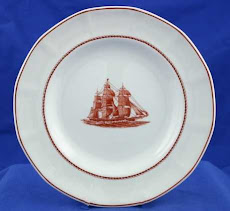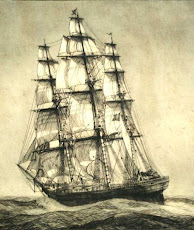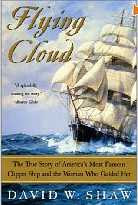Monday, October 13, 2008
The American Clipper, Flying Cloud
The engraving of the famous American Clipper Ship Flying Cloud presented here shows the ship as she surges forward in rolling seas towards an unknown port. She is heeling to leeward under full sails on a starboard beam reach. Many gulls are soaring off her starboard quarter. The artist, Burnell Poole, (1884-1933), spent years at sea in the North Atlantic with the U.S. Navy during WW One . Thirty years before our navy had combat artists, Poole recorded the warships in action. The U.S. Navy has less than two dozen works of art recording this period, and Poole's contributions number five. They were commissioned by E.I. Du Pont de Nemours and Company, and donated to the Naval Historical Foundation between 1928 and 1929 to commemorate the Navy’s participation in the war. These paintings, owned by the Navy Historical Foundation, are on exhibit in Washington, DC. Later, Poole turned to portraying the sea, by mastering the technique of engraving and dry-point. He earned a reputation as being the greatest American marine artists in those techniques. In 1922, he was being compared favorably to Englishman, Arthur Briscoe, 1873-1943. Poole also did engravings of many famous sailing yachts and ships and is applauded for his seascapes, navy and sailing ship works which all evidence the feelings of a true seaman. He engraved Flying Cloud in or about 1929.
Information extracted from www.landandsescollection.com which last sold the engraving in 2007.
Click here for images of come other ships appearing in the Flying Cloud pattern and their stories.
Wednesday, September 17, 2008
If anyone has any of the pieces followed with an * below, he may be interest in talking with you about purchasing them (please post a comment below to that effect).
Photos of each of the below pieces will soon be added to this web site.
Bowl | Soup bowl | 8 |
Bowl | Cream soup bowl | 8 |
Bowl | Oatmeal bowl | 8 |
Bowl | Rice bowl * | 3 |
Bowl | Dessert bowl | 8 |
Bowl | Small bowl (nut dish?) * | 1 |
Cup | Coffee cup | 9 |
Cup | Coffee cup saucer | 22 |
Cup | Tea cup | 13 |
Cup | Tea cup saucer | 9 |
Cup | Demitasse cup | 12 |
Cup | Demitasse cup saucer | 12 |
Cup | Jumbo cup | 8 |
Cup | Jumbo cup saucer | 8 |
Cup | Mug | 8 |
Other | Egg Coddler, double * | 2 |
Other | Egg cup, double * | 0 |
Other | Egg cups, single * | 6 |
Other | Egg Coddler, single | 10 |
Plate | Plate snack w/cup ring 9" * | 2 |
Plate | Plate Dinner 10" | 12 |
Plate | Plate Breakfast 9" * | 0 |
Plate | Plate Salad 8.5" | 12 |
Plate | Plate (round) 7" * | 0 |
Plate | Plate Bread 6"+ | 12 |
Plate | Plate Butter | 12 |
Serving | Ashtray large | 1 |
Serving | Ashtray small | 3 |
Serving | Soup Tureen, plate, ladle | 1 |
Serving | Sauce tureen, plate, ladle | 1 |
Serving | Tray oval 16.5" | 1 |
Serving | Tray oval 14" | 1 |
Serving | Tray oval 13" | 1 |
Serving | Tray oval 12" | 1 |
Serving | Tray oval 11" * | 0 |
Serving | Cake plate handled | 1 |
Serving | Cake plate | 2 |
Serving | Chop plate round | 1 |
Serving | Ice Bucket | 1 |
Serving | Vegetable dish, covered | 1 |
Serving | Vegetable dish, uncovered * | 5 |
Serving | Octagonal melon bowl | 1 |
Serving | Creamer (milk jug) ½ pt | 2 |
Serving | Creamer (milk jug) 1/3 pt | 0 |
Serving | Jam/Jelly bowl tall, lid * | 1 |
Serving | Butter box with lid | 1 |
Serving | Chinese (sugar) jar large | 2 |
Serving | Chinese (sugar) jar small | 2 |
Serving | Fruit Bowl large round | 1 |
Serving | Fruit Bowl small round | 1 |
Serving | Relish (leaf shaped) dish | 1 |
Serving | Pitcher | 1 |
Serving | Coffee pot large | 1 |
Serving | Coffee pot small * | 1 |
Serving | Coffee Pot mini * | 0 |
Serving | Tea pot, large (4 cup, 2 pt) | 1 |
Serving | Tea pot, small (2 cup, 1 pt) * | 0 |
Serving | Gravy Board attached plate | 1 |
Serving | Gravy boat | 1 |
Serving | Relish dish (Gravy boat plate) * | 4 |
Serving | Sandwich tray Large | |
Serving | Meat dish * | 0 |
Serving | Pickle dish * | 0 |
Sunday, September 16, 2007
Other American Clipper Ships Appearing in Flying Cloud Pattern

Although the easily recognizable image of the famous Flying Cloud clipper ship appears on most of the pieces in the pattern, the images of a few other famous clipper ships also appear on some of the pieces. In addition to their images, the names of those ships appear on the bottom of the pieces. Those pieces are as follows:
Top left - The Game Cock, launched on December 21, 1850. (A figurehead of a gamecock with an outstretched neck graced the bow of the heavily-sparred Game Cock clipper.) The Game Cock was owned by a man named Daniel C. Bacon. (Click here for a web site with more information.) By the way, the game Cock was launched the same day in the same shipyard in Boston as another clipper, the Witchcraft, which was slightly smaller than the Game Cock. My guess is that Wedgwood decided wisely decided against putting that name on any of its china.
Top right - The Ann McKim, launched in 1833. This ship, considered to the first clipper ship, was owned by Isaac McKim, who named it after his wife. Building it was considered a radical experiment at the time, but it then went on to become the model for many of the clipper ships built over the next 25 years. (Click here for more information.)
Bottom right - The Red Jacket clipper ship was built in Maine, from where, on November 2, 1853, she was towed to New York for final fitting of her mast and rigging. This extreme clipper ship, which set the unbroken speed record from New York to Liverpool, was named after Red Jacket (1750-1830) --- known as Otetiani in his youth and Segoyewatha ("he keeps them awake") after 1780 --- was a Native American Seneca chief of the Wolf clan and orator who traditionally wore a red jacket given to him by the British. As a tribute to her namesake, The Red Jacket carried a life-sized carving of him as a figurehead. She was also considered the handsomest of the large American built clippers until her end when, in a storm on December 15, 1885 she parted her moorings and was wrecked ashore. (Click here for more information.)
Bottom left - Tine Young America, launched April 30, 1853, in New York for George B. Daniels. On February 17, 1886, she passed the Delaware Breakwater outward bound from Philadelphia for Fiume and was never heard of again. (Click here for more information.)
The origins and evolution* of Wedgwood's fascination with the American clipper ship are perhaps known only to it, but the clipper ships appeared on the scene 38 years after Josiah Wedgwood's death in 1795. Perhaps it may be because those speedy clipper ships help speed the delivery of orders of Wedgwood's famous pieces around the world and the pattern was a tribute to their role in the growth of the company, especially in a growing America.
* Sspeaking of evolution, Charles Darwin was grandson of Josiah Wedgwood (and, I believe, Darwin married a Wedgwood relation). Darwin's famous ship, The Beagle, launched on May 11, 1820, was not an American clipper ship, given that it was launched on May 11, 1820, 13 years before the first American clipper, and was built at the Woolwich Dockyard on the River Thames in England.



